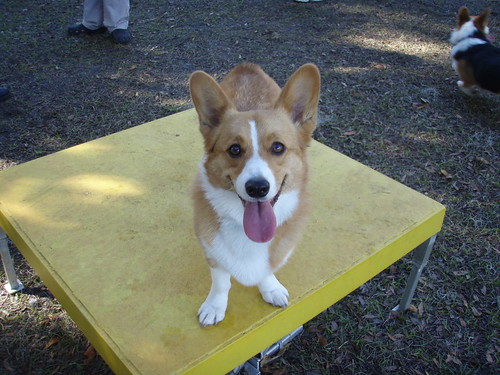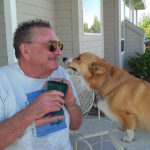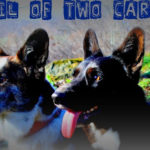
If you watch dog shows on TV, more than likely you’ve caught one showing a dog running around a field over, around, and through obstacles while a human yells and directs the dog along the way. It looks so easy and before you know it the dog has jumped into the humans arms while they smile and praise their dog for doing such a great job finishing the course.
Dog agility originated in England and has become a world-wide sport since it began in 1978. Different venues, or “clubs”, have created variations from the original rules but for the most part the idea is the same, run the course the fastest without making mistakes. Originally created to be purely entertainment, agility has turned into a real sport requiring lots of training and skill on both the part of the dog and the handler.

What sort of dog can train and compete in agility? Most ideal is a dog that loves to play with you, loves toys, loves food and loves to learning anything you want to teach it. The dogs that you see competing at the upper levels of agility typically come from herding breeds like the Border Collie, Shetland Sheepdog and Australian Shepard. Does this mean that you shouldn’t compete if you don’t have one of those breeds? Absolutely not – most venues accept dogs of any breed. The AKC even recently started accepting mixed breeds at their agility trials and other competitive events too.
- Drive: Hang around people that have been competing in sports like agility or herding and you will hear the word “Drive” pop up quite often. Drive is something you want bred into a dog and is rarely something you can train. Drive is the desire to work, learn and keep working. The more a dog wants to work the more “drive” they are considered to have. A dog with medium to high drive is considered to be the most desirable for agility because competitions can be exhausting and last for two to three days at a time. A dog with lots of drive will love training because they get to work for a reward over and over and over again. This goes for any sort of working sport.
- Health: Before training your dog you should have a vet check done to make sure the dog is healthy enough to begin agility training. Agility does require flexibility, good muscle tone and good joint health in a dog to perform. When choosing a dog for agility you should look at the parents and grandparents to see how healthy their body structure is as they age. Adopted dogs can be given a thorough health check too.
Corgis in particular need to have their health cleared as they can have back, hip and shoulder problems due to their dwarfism. Even if your corgi is always jumping around your house, on and off furniture you should still have them checked out prior to beginning training as it is a bit different than jumping off the couch.
If a dog hesitates or has trouble jumping or climbing obstacles where he was previously fine, this may be an indication that the dog is in pain and you should get him checked out immediately. This happened in a class that I was teaching, the owner was becoming increasingly frustrated at the fact that her dog was not wanting to jump over the very low jumps on the ground even when given new treats and encouragement. I suggested she have the dog checked out because it did indicate pain. Weeks later they took the dog in and found that the dog had a luxating patella that required immediate surgery.
Corgis in particular seem to be rather stoic even when they are in pain and will try to perform if you ask. Because of this it is very important to watch your dog and make sure you warm up and stretch them before and after practice. Note any differences in performance as this might indicate an underlying health issue.
- Age: Most agility clubs will not allow a dog under the age of 15-18 months to compete. This is for safety and also due to the maturity of the dogs body. All dogs are born with growth plates that take 12-18 months to close completely in the joint areas. The only way to find out if the growth plates have closed is to have an x-ray done and read by a veterinarian. Why is this important? When you train agility the dog is asked to do many repetitions that cause impact on the joints where the growth plates close. Should a dog that is too young with unclosed growth plates do many repetitions the plates might not grow together properly. This can cause injury later in life and greatly shorten the ability to run agility.
Most dog sport homes recommend not spaying or neutering until the dogs growth plates have closed so they have time to grow in properly. It is also believed that waiting later to spay or neuter prevents the dog from maturing too rapidly causing them to grow taller than normal and/or not developing proper muscle tone. (Reference: Chris Dink, DVM)
Until the growth plates are closed you will have to abstain from training obstacles at full height. This means jump bars should be placed at elbow-height or lower, the dogs should not be asked to weave poles in a straight line and they should not be doing contact obstacles (teeter, dog walk and A-frame) at full height to prevent growth plate damage. Puppies benefit from training on lower obstacles and do very, very well when they are trained from a young age. There is a misconception that a jump has to be at the full height in order to properly train the dog on it. Jump poles on the ground can teach the same foundations as a jump pole set at competition height for a dog.
- Attitude: A good agility dog is brave, curious and willing to please. If you have a dog that is shy or unsure of trying new things like walking on strange footing this is a great sport to help them build confidence as long as you take it at a slow pace. The sport is a team sport between the dog and the handler so you must have a good relationship with your dog. They should love to play with you! If you teach this to your dog from the moment he comes home you will go a long way.
- Play: Ideally, you want to look for a dog that loves to play either with toys or loves to work for food and will do anything to get it. Dogs that love to tug on toys, chase tennis balls, jump in the air to get those treats will be easily trained.




Nicely done! Good intro. Keep your fingers crossed that Riley will Q today in his AKC agility trial!
Wonderful post — thank you so very much. My dogs think agility is HUGE fun, and they are correct.
THIS IS AN AWESOME POST!! I am an agility addict and am training and competing with my first Corgi (Pippin). He has all the great qualities one wants in an agility dog and you have captured them all here. Unfortunately he has had a very bad reaction to his Rabies booster so I have to contend with that and we have to take time off periodically because he gets sore… but no matter what, I LOVE my agility Corgi! Laurie, i would love to see more posts dedicated to agility Corgis!!
Wonderful Post and Video!!!! Thank you so much for sharing!!!!
my Corgi Winston was a wonderful agility dog. After a year, tho, he became bored, ran into the tunnel one day and just sat down. . . as if to say, I'm so over this. RIP my friend.